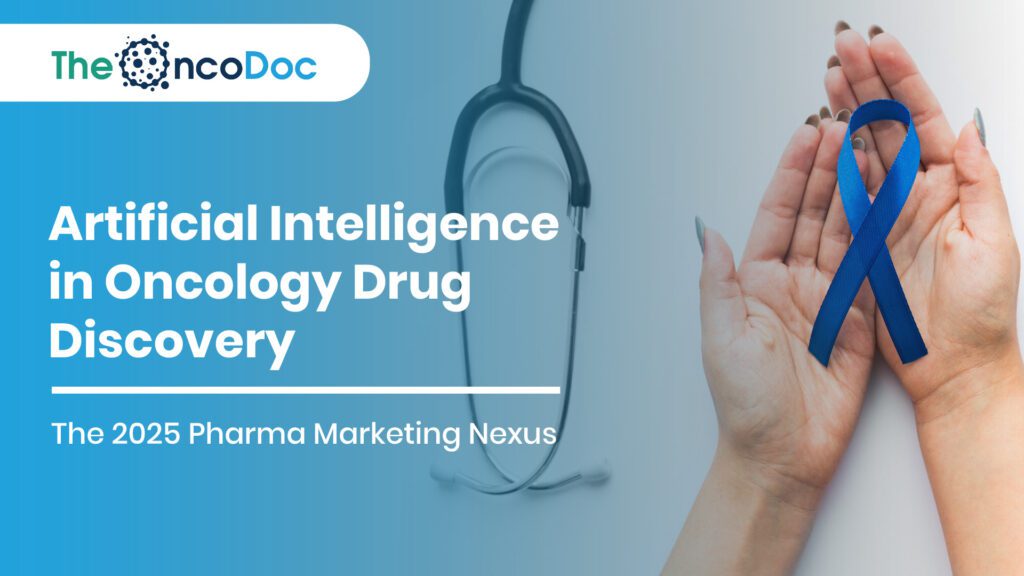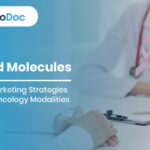Introduction: A New Convergence Between Science and Storytelling
The year 2025 marks a pivotal shift in how cancer drugs are not only discovered but also positioned, marketed, and integrated into the patient journey. Artificial Intelligence (AI) has emerged as the most powerful catalyst in oncology drug discovery, compressing timelines, increasing success rates, and unlocking novel therapeutic possibilities. But beyond the lab bench, these breakthroughs demand a marketing transformation that communicates complex AI-driven science to oncologists, patients, regulators, and investors alike.
Pharma marketing teams now find themselves at the intersection of cutting-edge R&D and patient-centric communication. Their challenge is twofold:
- Translate AI-powered breakthroughs into accessible, credible narratives.
- Ensure these innovations reach the right audiences, clinicians, patients, and policymakers, at the right time, through the right channels.
This article explores the state-of-the-art fusion between AI-driven oncology drug discovery and pharma marketing in 2025, detailing how data intelligence, precision engagement, and ethical storytelling are reshaping the industry.
1. The Paradigm Shift: From Molecule-First to Patient-First Discovery
Historically, cancer drug discovery was driven by molecular curiosity, identifying a protein, developing a molecule, and hoping for efficacy. AI has inverted this model. In 2025, discovery often begins with patient-derived data, genomic sequences, biomarker profiles, and digital health footprints, feeding into AI algorithms to suggest the most promising therapeutic paths.
For pharma marketers, this means drug positioning now starts at the level of patient impact, not just molecular innovation. Campaigns emphasize:
- Who benefits most (e.g., biomarker-positive patient segments).
- How the AI model validated the approach.
- Why it accelerates access to potentially life-saving therapies.
By making the patient the starting point of the story, marketing aligns perfectly with AI’s data-first science.
2. AI as a Differentiator in Competitive Oncology Markets
In saturated oncology markets, differentiation is crucial. AI has become a core branding pillar for new drug launches. Companies now emphasize their proprietary AI platforms in marketing collateral, presenting them as an assurance of speed, precision, and reduced development risk.
Pharma brand strategies include:
- Platform Branding – Naming and marketing their AI engines (e.g., “OncoVisionAI™”).
- Pipeline Transparency – Sharing AI-driven discovery timelines compared to industry averages.
- Predictive Efficacy Messaging – Highlighting AI’s role in selecting patient cohorts with the highest expected treatment benefit.
This approach not only positions the drug but also establishes the company as an innovation leader in oncology.
3. Data-Driven Market Segmentation in AI-Discovered Therapies
AI’s influence doesn’t stop at drug development, it extends into hyper-segmentation of target markets. For example, an AI-designed lung cancer therapy might be most effective in EGFR mutation-positive, non-smoking Asian females under 50. Marketing teams can now precisely target such segments with tailored content.
Key tactics include:
- Geo-genetic Targeting – Mapping where specific mutations are most prevalent and running localized awareness campaigns.
- Clinical Persona Development – Creating detailed clinician profiles based on prescribing habits, patient demographics, and openness to AI-based evidence.
- Real-Time Campaign Adjustment – Using ongoing trial data to refine messaging mid-campaign.
4. Educating Oncologists on the AI Advantage
While AI is transforming oncology research, not all clinicians are immediately comfortable with algorithm-assisted drug discovery. Marketing must therefore bridge the trust gap.
Effective education campaigns in 2025 include:
- AI Literacy CMEs – Online modules explaining AI model validation, bias mitigation, and case studies.
- Trial-to-Practice Webinars – Sessions led by trial investigators on translating AI-discovered trial data into clinical decision-making.
- Data Visualization Tools – Interactive platforms allowing oncologists to explore how AI identified the drug target.
By making AI transparent and clinically relatable, pharma companies accelerate adoption.
5. Storytelling That Humanizes the Algorithm
AI in healthcare is frequently criticized for feeling impersonal and “cold”. Successful 2025 marketing humanizes the algorithm by showing:
- Patient Journeys – Stories of individuals who benefited from AI-discovered therapies, focusing on improved outcomes and quality of life.
- Researcher Spotlights – Profiles of scientists who collaborated with AI tools.
- AI as a Partner, Not a Replacement – Stories that present AI as a tool to support human creativity rather than a challenge to medical knowledge.
These elements make the science emotionally resonant while maintaining credibility.
6. AI-Driven Content Personalization for HCP and Patient Audiences
AI not only designs drugs but also powers pharma marketing engines themselves. AI will be used by campaigns in 2025 to examine stakeholder involvement trends:
For Physicians: Personalized case study recommendations based on specialty and patient load.
- For Patients: Tailored educational videos explaining how the drug targets their specific mutation.
- For Policymakers: Briefing documents predicting potential cost savings and public health benefits.
7. The Regulatory Story: Turning Compliance into a Marketing Asset
With the FDA’s 2025 draft guidance on AI in drug development, compliance is no longer just a legal box to tick, it’s a competitive marketing asset. Pharma marketers now highlight:
- Explainability of AI models.
- Third-party validation reports.
- Diversity metrics in training datasets.
By making regulatory transparency part of the story, brands reassure both clinicians and patients that AI-discovered drugs meet rigorous safety and efficacy standards.
8. AI-Powered Drug Repurposing: Strategic Marketing Potential
AI has completely changed drug repurposing in 2025 by identifying novel cancer uses for previously approved medications. This not only reduces the cost and risk of drug development but also dramatically shortens the path from discovery to patient availability.
From a marketing perspective, AI-driven repurposing offers a dual advantage:
- Scientific Credibility – Supported by strong safety profiles and clinical evidence from prior indications.
- Speed-to-Market Storytelling – Positioning the therapy as a rapid-response innovation for urgent cancer needs.
The most successful pharma brands in 2025 are using targeted strategies to highlight these benefits and maximize adoption.
Table: Marketing Strategies for AI-Repurposed Oncology Drugs (2025)
| Strategic Focus | Implementation Tactics | Marketing Impact |
| Safety Assurance Messaging | Highlight long-term safety data from original indication in campaigns and HCP briefings. | Builds clinician confidence and accelerates prescribing decisions. |
| Cost-Effectiveness Framing | Showcase reduced R&D investment and affordability in payer-focused communication. | Increases formulary acceptance and payer support. |
| Rapid Innovation Narrative | Emphasize “discovered and launched within X months” in press releases and media coverage. | Positions the brand as a fast-moving leader in oncology innovation. |
| Patient Familiarity Leverage | Use patient advocacy groups to explain that the drug is already trusted in other diseases. | Reduces hesitation among patients and caregivers. |
| Evidence Acceleration | Publish AI-driven data visualizations showing new cancer-target efficacy from repurposing. | Reinforces scientific credibility and transparency. |
9. AI-Powered Market Forecasting for Launch Timing
The same predictive models that drive discovery can also forecast market receptivity. AI can analyze:
- Upcoming competitor launches.
- Shifts in clinical guideline recommendations.
- Real-world evidence from early access programs.
Marketing teams use these insights to time product launches for maximum impact, often synchronizing with major oncology conferences or awareness months.
10. Influencer KOLs in the AI-Oncology Space
In 2025, the most influential Key Opinion Leaders (KOLs) aren’t just top oncologists, they’re also digital-native, AI-literate clinicians who can interpret algorithmic results for peers.
Pharma partnerships with such KOLs include:
- Joint-authored whitepapers explaining AI-driven trial outcomes.
- Live case discussions where KOLs review anonymized patient cases identified by AI.
- Social media Q&A sessions breaking down AI findings in plain language.
11. Ethical Storytelling: Addressing Bias and Equity
Given the ethical concerns around AI bias in healthcare, marketing must proactively address these issues. Campaigns now include:
- Dataset Diversity Metrics – Demonstrating inclusion of underrepresented populations in AI model training.
- Equity Impact Statements – Showing how the drug will be accessible to rural or low-income patients.
- Bias Mitigation Roadmaps – Outlining ongoing improvements in AI model fairness.
By doing these actions, you can increase brand and medicine trust.
12. Integrating Diagnostics and Drug Marketing
AI’s role in drug discovery often overlaps with diagnostics, such as identifying biomarkers for patient selection. Marketing strategies now integrate both:
- Dual Launch Campaigns – Presenting the medication and its complementary test.
- Biomarker Education Drives – Training HCPs to order relevant tests early.
- Patient-Facing Genetic Literacy Tools – Helping patients understand how their DNA informs treatment.
This integration strengthens the precision medicine narrative.
13. Digital Twins: The Future Patient Engagement Tool
AI-powered digital twins, virtual models of patients, are being used to simulate treatment outcomes. In marketing, these tools can:
- Demonstrate drug efficacy in simulated patient populations.
- Help clinicians visualize therapy impact on disease progression.
- Offer patients a personalized projection of their potential response.
This futuristic element can be a high-engagement centerpiece in launch events and medical conferences.
14. Real-World Evidence (RWE) as a Marketing Lever
Post-approval, AI continues to collect and analyze real-world evidence from electronic health records, wearables, and patient-reported outcomes. Marketing teams use RWE to:
- Publish data refreshes showing sustained efficacy.
- Produce impact dashboards for HCPs and payers.
- Support label expansion applications with ongoing AI-monitored data.
RWE storytelling reassures stakeholders that benefits extend beyond controlled trial environments.
15. AI in Global Oncology Market Access
In emerging markets, AI-driven discovery has the potential to deliver affordable, context-specific cancer therapies. Marketing here focuses on:
- Local Relevance – Showcasing region-specific trial data.
- Partnerships with Local NGOs – For awareness and distribution.
- Vernacular Campaigns – Delivering AI impact stories in native languages.
This ensures innovation doesn’t remain confined to developed economies.
16. Omnichannel AI-Backed Launch Strategies
AI is making omnichannel launch planning more precise. Predictive analytics recommend the optimal channel mix for each audience, factoring in:
- Digital behavior.
- Specialty area.
- Geographic access.
This results in higher ROI and lower wasted spend on ineffective channels.
17. Post-Launch AI Monitoring for Campaign Optimization
Post-launch, AI tracks:
- Physician prescribing patterns.
- Patient adherence rates.
- Social sentiment.
These insights allow real-time campaign pivots, for example, shifting focus to adherence messaging if early data shows drop-offs.
18. Virtual & Augmented Reality for AI-Drug Education
Pharma firms are visualizing AI-driven medication processes with VR and AR:
- VR Walkthroughs of how the drug binds to a target protein.
- AR Apps overlaying trial data onto real-world patient case discussions.
- Conference Booth Simulations allowing attendees to “step inside” AI’s discovery process.
These tools simplify complex science for a variety of audiences.
19. AI in Compassionate Use and Early Access Programs
AI helps identify patients most likely to benefit from a drug still in development, enabling targeted compassionate use programs. Marketing teams:
- Publicize case studies from early access.
- Engage advocacy groups to spread awareness.
- Build goodwill by emphasizing patient-first access.
20. The Road Ahead: Predictive, Preventive, and Personalized
Looking to 2030, AI in cancer drug discovery will:
- Predict disease onset years before symptoms.
- Prevent progression through ultra-early interventions.
- Personalize therapies at a genetic and lifestyle level.
Pharma marketing will evolve into a continuous engagement model, where education, adherence, and real-world validation are as important as the launch itself.
Conclusion: The AI-Marketing Synergy as a Growth Engine
In 2025, the synergy between AI-driven oncology drug discovery and strategic pharma marketing is no longer optional, it’s the growth engine for the industry.
AI is accelerating discovery, while marketing is ensuring these breakthroughs are understood, trusted, and adopted. The companies that master this integration, combining scientific credibility, patient empathy, and data-driven precision, will not only dominate market share but also redefine how humanity fights cancer.
The winners will be those who realize that in the AI era, the drug is only half the story, the other half is how you tell it.
The Oncodoc team is a group of passionate healthcare and marketing professionals dedicated to delivering accurate, engaging, and impactful content. With expertise across medical research, digital strategy, and clinical communication, the team focuses on empowering healthcare professionals and patients alike. Through evidence-based insights and innovative storytelling, Hidoc aims to bridge the gap between medicine and digital engagement, promoting wellness and informed decision-making.



